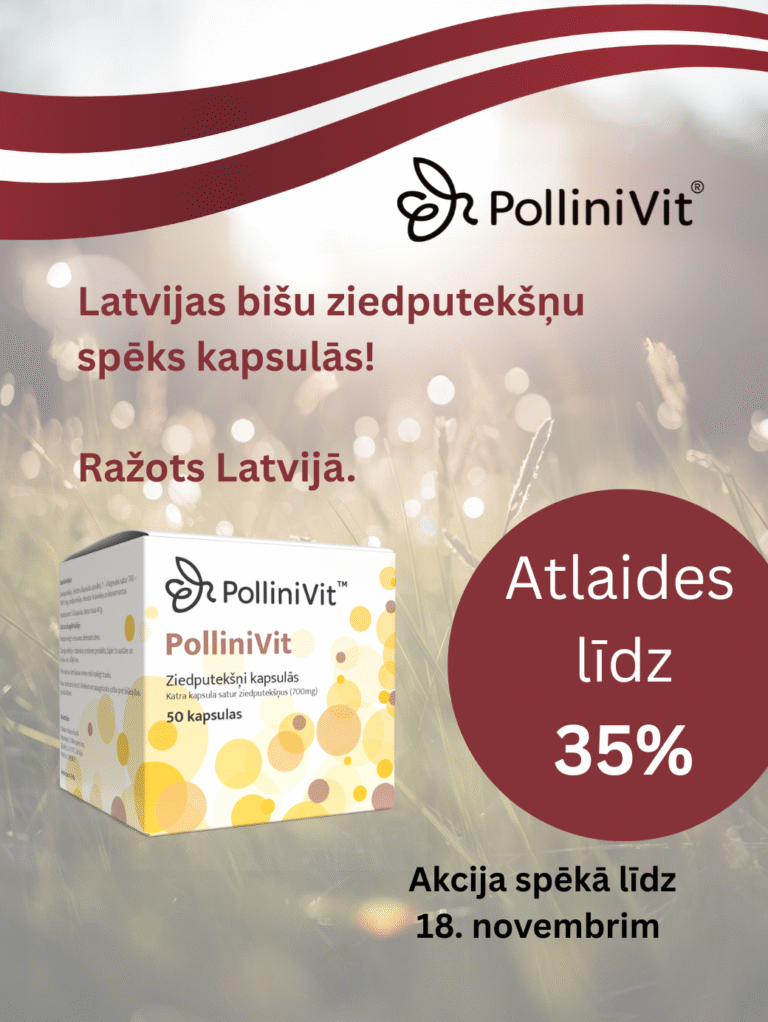Author of the article: Dr. Pavels Janovics, physician, gastroenterologist.

What is bee pollen?
Bee pollen is one of the most valuable products of natural origin, due to its extremely wide range of nutritional compounds and trace elements. This composition can be influenced by botanical origin, harvest time and storage methods.
Bee pollen is the male part of plant flowers, which bees collect and use as protein feed. Bees brush off the adhering pollen with their feet, forming pollen bags. To prevent them from falling out on the way to the hive, bees add nectar and saliva, crush them into balls with their jaws and place them in special baskets on their hind legs. The weight of a bag is on average 7.6 mg, and to collect 1 kilogram of pollen, bees must fly out of the hive 45-67 thousand times.
Bee pollen has a pleasant aroma, the taste varies from very sweet to sweet with a slight bitterness, they differ in both shape and color, everything depends on the plants from which they are collected.
It is known that nectar and bee pollen are the main sources of nutrients necessary for the survival and health of bee colonies. Nectar is mainly produced by the nectar glands of plants, and it serves as a raw material for the production of honey, while bee pollen is the male gametophyte of the plant. They are in the form of fine dust with small particles, the color of which varies depending on the origin of the flowers. Flower nectar provides bees with carbon and nitrogen, while bee pollen provides other nutritional components, such as lipids, proteins, vitamins and minerals.
What does it contain?
If we compare bee pollen with honey, then bee pollen significantly surpasses honey in terms of the presence of various biologically active components.
Bee pollen, which is high in protein, could guarantee an ideal diet in terms of protein requirements. Furthermore, bee pollen is the main source of protein for bees, providing the necessary elements for their longevity, organ development, larval growth and body size. The protein content varies greatly between plant species and geographical areas of collection, and ranges from 10 to 40% of the pollen dry matter.
Amino acids are very important not only for protein synthesis, but also for the biosynthesis of hormones and other molecules with a biological role. In terms of nutrition, two types of amino acids are distinguished, namely essential amino acids, which the human body cannot synthesize, and non-essential amino acids, which our body can synthesize. In this context, pollen collected by bees is often considered the “most natural ideal food”, as it is an excellent source of all the essential amino acids required in the diet of honeybees and humans. This content varies greatly between species and depends on botanical and geographical origin, climatic conditions and nutrient availability in the plants. The total amino acid content of bee pollen has been quantified by many researchers and generally ranges from 108.1 to 287.7 mg/g. Regarding the amino acid profile, De-Melo and Almeida-Muradian have reported twenty-five amino acids, eight of which are essential (valine, leucine, isoleucine, lysine, phenylalanine, threonine, histidine and methionine). Tryptophan is usually not detectable, as the hydrolysis method used to determine amino acids is used. However, tryptophan has been found in bee pollen using specific high-performance liquid chromatography methods. Other amino acids have also been found in bee pollen, such as aspartic acid, alanine, glycine, glutamine, arginine, asparagine, glutamic acid, serine, tyrosine, cystine, cysteine, γ-aminobutyric acid (GABA), ornithine, proline, and homoserine. Proline has been reported to be the most abundant amino acid in dried bee pollen in many countries, while glutamic acid is the main amino acid in freshly collected bee pollen.
Bee pollen contains a large number of carotenoids and tocopherols. Unique substances such as cholecalciferols and ergocalciferols, as well as rutin and B vitamins. In addition to the above substances, it contains quite a lot of ascorbic acid, and when looking at the mineral composition, bee pollen contains a full set of trace elements. Almost the entire periodic table can be found in it, from potassium and phosphorus to titanium and barium. Such a rich composition can significantly positively stimulate all biological processes in the body.
Bee pollen sugar contains both reducing sugars and individual sugars with a predominance of glucose and fructose as monosaccharides, which make up the largest sugar fraction. Sucrose, maltose, trehalose, turanose and melezitose have also been identified in bee pollen. The sugar content and profile can be significantly affected by the nectar that bees add to the collected pollen. The source of the flower, the drying process and the extraction methods can also significantly affect the sugar content.
Beneficial properties of bee pollen
Bee pollen:
- increases human endurance during mental and physical exertion;
- increases tone and rejuvenates the body;
- helps to endure menopause more easily;
- improves appetite;
- improves immunity;
- prevents burning sensation and pain in the stomach and intestinal tract, relieves bloating, diarrhea, constipation;
- reduces cholesterol levels, improves lipid profile in the body and heart health;
- immunomodulating effect, as it contains vitamins and a full set of microelements;
- helps to normalize blood circulation and improve its composition, as it improves spleen function;
- improves the functioning of the endocrine system;
- anti-stress effect, perfectly relieves tension;
- helps to strengthen blood vessels, as it contains ascorutin, a lot of ascorbic acid;
- helps to detoxify the liver, stimulates the regeneration of liver cells;
- strengthens the ability to react to adverse conditions, activates leukocytes to fight foreign bodies in the blood, strongly promotes the regeneration of body tissues in case of damage;
- prevents sexual disorders;
- activates all metabolic processes;
- helps the body fight neuroses, depression;
- after poisoning with chemical compounds, improves the body’s detoxification ability, therefore bee pollen is recommended for people living in chemically polluted environments;
- improves choleretic, diuretic, anti-inflammatory properties of the body;
- there is data on preventive anticancer effects;
- antioxidant properties.
The German Ministry of Health has officially recognized bee pollen as a medicine.
When using bee pollen, one should remember about the associated allergy (PRFA), which can cause symptoms after ingestion and usually disappears spontaneously within 10–30 minutes, however, PRFA should not be forgotten.
Currently, the potential of bee pollen has been recognized in many medical areas and research is underway, including using an inoculum of good bacteria (Lactobacillus rhamnosus). By performing partial fermentation of bee pollen, the composition of fermented pollen was analyzed, compared to natural bee bread and original pollen and seems to be a promising imitation of the formation of bee bread, improving the intestinal microbiota and potentially contributing to the hypoallergenicity of bee pollen products.
The use of pollen together with probiotics would be potentially recommended, due to its prebiotic effect, with the high proportion of soluble and insoluble fiber from plant-based foods, which includes hemicellulose, cellulose, lignin, oligosaccharides, pectins, gums and waxes; these compounds are resistant to digestive enzymes, so they are not hydrolyzed or absorbed in the intestinal tract. Many recent studies have confirmed the essential physiological role of dietary fiber in the human body; indeed, it is involved in the treatment of type 2 diabetes by selectively promoting certain intestinal microbiota. A high-fiber diet has been found to be effective in many conditions, such as obesity-related disorders, cardiovascular disease, constipation, inflammatory bowel disease, and colon cancer. In this regard, bee pollen can be a good source of dietary fiber, especially coarse fiber.
The list of beneficial properties is very extensive, it is truly a storehouse of health. How to use?
The procedure for using the product is quite simple, as a preventive measure it is recommended to take bee pollen 2-3 times a day, half an hour before meals, in the form of a course. The bee pollen course (about 20 -30 days) should be repeated twice a year: in autumn and spring.
For children, bee pollen is especially recommended in the autumn/winter and spring seasons, when strength is depleted and there are no other natural vitamins. For children aged 3-5, it is recommended to use it once a day.
The dose can be increased if a person has eating disorders, overload, a weakened body, has suffered serious illnesses and has used large doses of medications.
To improve the absorption of bee pollen’s valuable substances, it is recommended to use bee pollen in crushed form.
Author of the article: Dr. Pāvels Janovičs, physician, gastroenterologist

